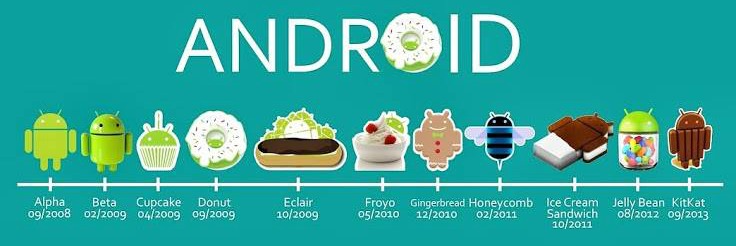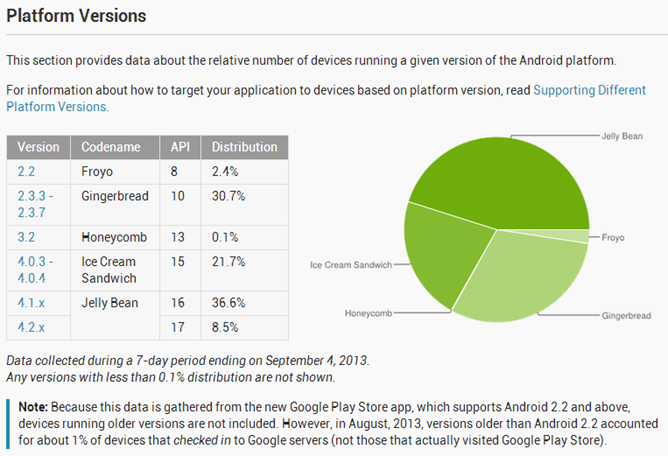Today the word Android is no alien word. There is absolutely no denying that Android OS has occupied quite a large space in the market since Google launched the Android OS five years back in 2008. Currently Android is on over 331 million smartphones with close to a million joining every day. By far the Android app store features 600,000 apps and over billion-app downloads happen by monthly from Google Play. But this success didn’t come overnight. Let’s have a look at the success journey of Android OS.
Android 1.0
Google bought Android Inc. back in July 2005 and Android OS, started its journey with the HTC-made T-Mobile G1. Android 1.0 was launched in Sept 2008 and was packed with enabled camera support, Wi-Fi, Bluetooth, folders, a web browser, notifications, voice dialing, YouTube, alarm clock, gallery, instant messaging, media player, and the whole Google apps array and Android Market. It marked the beginning of a new technology era.
Android 1.5 (Cupcake)
Android 1.5 was the first version of Android to have a code name “Cupcake”. It was the first commercially available version of Android packed with features like Universal search box, Support for third-party virtual keyboards, Video recording and upload to YouTube, toggle between camera and video modes; several built-in widgets like calendar, music player and picture frame, redesigned Android Market with Browsing categories that included Apps, Games, Downloads and filters, support for gestures and voice-to-text option.
Android 1.6 (Donut)
Released in Sept 2009, Android 1.6 also known as Donut included numerous updates to text, voice, and searching. It also supported WVGA screen resolutions, which is equivalent to 800 x 480 and addressed the reboot errors. It included several new features like Android Search, option of direct upload to YouTube and Picasa, Expanded Gesture framework and new Gesture Builder development tool, Home screen widgets and folders, handwriting gestures, Stereo Bluetooth, and Google turn-by-turn navigation.
Android 2.0/2.1 (Éclair)
Éclair, Android 2.0 was launched in Oct 2009 followed by the launch of 2.1 in January 2010. Android 2.1 served mainly as a bug fix release which included a changed API, so it shared the Éclair codename. It came with many new features like extended account sync for multiple accounts, exchange email support, Bluetooth 2.1, new camera features, an improved Android keyboard, optimizations for speed, a revamped user interface, a refreshed browser with HTML5 support, and support for live wallpapers.
Android 2.2 (Froyo)
Android 2.2 codebase nicknamed Froyo released in May 2010, offered many performance improvements like the addition of the JIT (just-in-time) compiler for even more speed, integration of the V8 JavaScript engine in the browser, support for push notifications, better Exchange support, USB tethering and Wi-Fi hotspot, voice dialing over Bluetooth, support for screens of up to 320 ppi, USB Tethering, Portable Wi-Fi Hotspot, OpenGL improvements to improve gaming graphics and performance and Adobe Flash support.
Android 2.3 (Gingerbread)
Android 2.3 was released with the name Gingerbread in December 2010. This OS came with cool features like support for resolutions of 1280 x 768 and higher, SIP Internet calls, support for multiple cameras, enhanced copy and paste functionality, revamped UI, voice and video support for Google Talk, support for gyroscope, barometer, gravimeter, switch to front-facing camera from camera app, garbage collection for increased performance, and support for near field communication. The 2.3.7 release also offered Google Wallet support for the Nexus S 4G.
Android 3.0/3.1/3.2 (Honeycomb)
The Android 3.0, Honeycomb designed keeping tablets in mind was released in Feb 2011 followed by two rapid bug-fix versions like 3.1 and 3.2, which came out in July and August 2011 respectively. The main features of Honeycomb OS were optimized Tablet UI, revamped widgets and better multitasking, private browsing, USB Host, Dual-pane modes for address book, e-mail, redesigned keyboard and improved copy/paste video chatting with Google Talk, 3D graphics support, multi-select, clipboard, and drag-and-drop option, New APIs for Bluetooth A2DP and HSP and full-screen-mode photo gallery.
Android 4.0 (Ice Cream Sandwich)
Android 4.0, also known as Ice Cream Sandwich was first released in Oct 2011 and updated in March 2012. The OS is designed to work both on smartphones and tablets. The release introduced the ability to use software buttons on the touchscreen instead of hardware buttons for things like Home, Back, and Menu. Android 4.0 OS also includes virtual buttons, Face Unlock, Android Beam, revamped Gmail user interface, saving web pages offline, Roboto a new typeface, improved voice integration and copy and paste, new camera capabilities, screenshot option and more.
Android 4.1 (Jelly Bean)
The most recently released Android 4.1 OS, codenamed Jelly Bean aims to improve the user interface and performance, using items such as touch anticipation, enhanced vsync timing, triple buffering in the graphics pipelines, enhancements to Android Beam, addition of Google Now, multichannel audio, and USB audio. The overall experience is supposed to be “buttery smooth” so that the user feels the device responding to input immediately. The expected features include File manager, Jelly Bean Lite – a lighter version of Android OS for midrange and lower end smartphones, integrated Google Chrome, Battery, Power Distribution and Efficient OS, Efficient Upgrade and more.
Android 4.4 (KitKat)
Google sent a shock through the Android community recently when it announced the next version of Android will be Android 4.4, KitKat. It came as a big twist from the long-standing expectation that this fall’s release would be numbered 5.0 and called Key Lime Pie. Google will primarily push Android 4.4 KitKat on its Nexus line, Nexus 5 and the rumored Nexus 11 tablet. Hopefully after that, LG Nexus 4, Nexus 7 2013, Nexus 7 2012 and Nexus 10 will also receive the update push eventually. Google isn’t confirming anything so far, but they have hinted what Android fans may expect on the next major version.
Our evolution story is by no means complete, as we are trying to pin down 4 years of technology revolution- so if we missed anything feel free to share with us in the comments. Keep visiting us for more updates.

